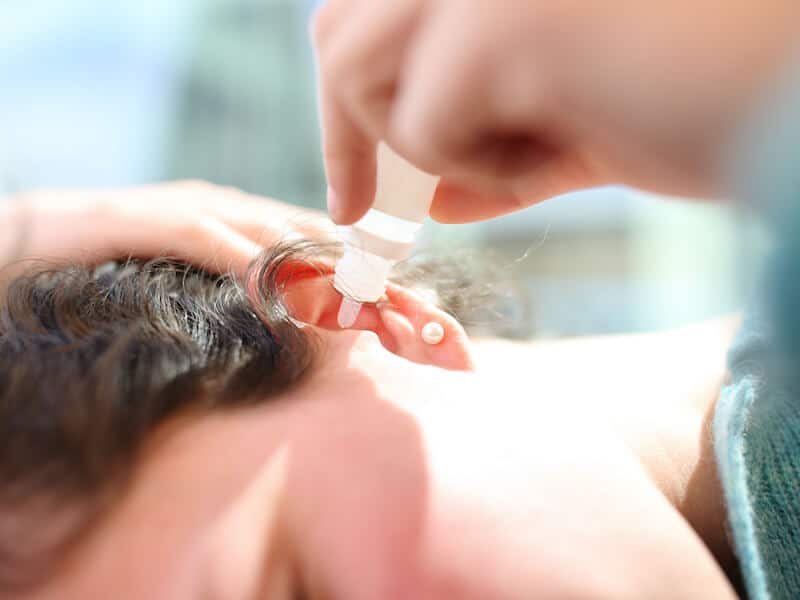- Why DIY Repairs Could Harm Your Hearing Aids - April 15, 2025
- Hearing Protection Solutions for Teamwork - April 6, 2025
- The Role of ABR in Identifying Auditory Neuropathy Spectrum Disorder - March 27, 2025
Earwax, also called cerumen, is a natural substance produced by glands in the ear canal. Its primary role is to protect the ears from dust, microbes, and foreign particles to prevent damage and infections.
While earwax is beneficial for ear health, excessive or impacted earwax can lead to discomfort, hearing loss, tinnitus, and sometimes infection. Here’s how you should be dealing with earwax to maintain optimal ear health.
Understanding Earwax and Its Importance
Before diving into how to manage earwax, it’s important to understand what it is and why our bodies produce it. Earwax is a secretion from the ceruminous and sebaceous glands in the outer ear canal. This sticky substance traps dust and other foreign particles, preventing them from reaching the eardrum. Earwax also has antibacterial and antifungal properties, offering an additional layer of protection against harm.
Recognizing Symptoms of Earwax Buildup
The body generally maintains a self-cleaning mechanism where earwax and trapped debris naturally exit the ear. As the earwax dries out, it moves to the top of the ear canal during activities like chewing and talking. Eventually, this dried-out earwax falls out of the ear canal or gets washed away in the shower.
However, sometimes earwax can accumulate and harden, leading to a blockage in the ear canal. Signs of excessive earwax include:
- Earache
- A feeling of fullness in the affected ear
- Tinnitus or ringing in the ear
- Hearing difficulties
- Dizziness
- Odor or discharge from the ear
If you experience any of these symptoms, it might indicate a need for earwax removal. If any symptoms are severe, seek medical attention as soon as possible.
Safe Removal Practices
It’s important to approach earwax removal safely to avoid damaging the delicate structures of the ear. Here are recommended practices:
1. Over-the-Counter Drops
Ear drops specifically designed to soften earwax can be a gentle first step. These drops usually contain hydrogen peroxide or mineral oil, aiding in softening the wax for natural removal.
2. Professional Water Irrigation
After softening the earwax with drops, gently irrigating the ear with warm water using a syringe can help flush out the softened wax. However, this step should only be done by a medical professional.
3. Microsuction by a Professional
For impacted earwax or if the above methods are unsuccessful, seek professional help. Specialists can use microsuction, a procedure that involves using a microscope and a small suction device to remove earwax safely.
Practices to Avoid
Certain common practices can be harmful and should be avoided:
- Cotton Swabs: Inserting cotton swabs into the ear canal can push earwax further in, leading to impaction and blockage.
- Ear Candling: This controversial method poses risks such as burns and even eardrum perforation. There is no scientific evidence to support its effectiveness.
- Sharp Objects: Never use pins, keys, or other sharp objects to remove earwax. They can cause serious injury.
Preventative Measures
Maintaining a healthy earwax balance involves certain preventative measures:
- Avoid Overcleaning: Allow the ear’s natural cleaning process to occur. Overcleaning can strip the ear of protective earwax.
- Protect Your Ears: In dusty or particle-rich environments, wear ear protection to prevent excessive earwax laden with debris.
- Healthy Diet: A diet rich in omega-3s and vitamins can promote healthy earwax production.
When to See a Doctor or Hearing Professional
While earwax management can often be handled safely at home, certain situations require medical attention:
- Persistent symptoms despite home treatment
- Sudden or severe hearing loss
- Pain, fever, or oozing, indicating an infection
- A history of ear surgeries or eardrum perforation
In such cases, a healthcare professional can assess and provide the appropriate treatment, which may include professional earwax removal or addressing any underlying issues.
Key Takeaways
Earwax plays a significant role in ear health, but it’s important to manage it properly to avoid complications. Recognizing the signs of earwax buildup, practicing safe removal techniques, and understanding when to seek professional help can ensure your ears remain healthy
Visit us For Earwax Removal
Remember, your ears are delicate organs that must be treated with care. Whether it’s preventive maintenance or addressing a buildup, the right approach to managing earwax can make all the difference in preserving your hearing health. That’s why we offer earwax removal. Our team uses gentle irrigation, microsuction, or manual removal. Contact us today to book a consultation.

